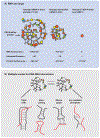Formation, function, and pathology of RNP granules
- PMID: 37890457
- PMCID: PMC10617657
- DOI: 10.1016/j.cell.2023.09.006
Formation, function, and pathology of RNP granules
Abstract
Ribonucleoprotein (RNP) granules are diverse membrane-less organelles that form through multivalent RNA-RNA, RNA-protein, and protein-protein interactions between RNPs. RNP granules are implicated in many aspects of RNA physiology, but in most cases their functions are poorly understood. RNP granules can be described through four key principles. First, RNP granules often arise because of the large size, high localized concentrations, and multivalent interactions of RNPs. Second, cells regulate RNP granule formation by multiple mechanisms including posttranslational modifications, protein chaperones, and RNA chaperones. Third, RNP granules impact cell physiology in multiple manners. Finally, dysregulation of RNP granules contributes to human diseases. Outstanding issues in the field remain, including determining the scale and molecular mechanisms of RNP granule function and how granule dysfunction contributes to human disease.
Copyright © 2023 Elsevier Inc. All rights reserved.
Conflict of interest statement
Declaration of interests The authors declare no competing interests.
Figures




References
Publication types
MeSH terms
Substances
Grants and funding
LinkOut - more resources
Full Text Sources

